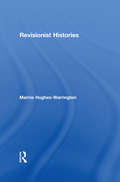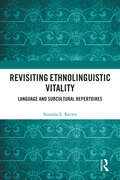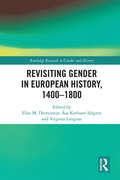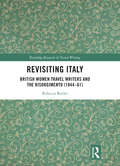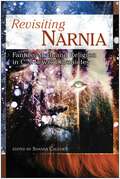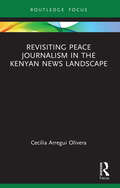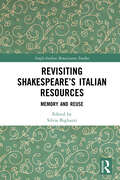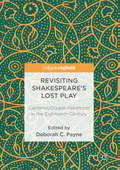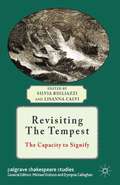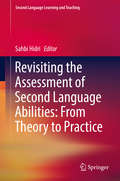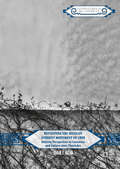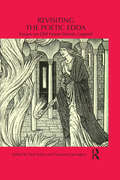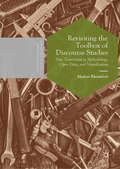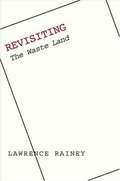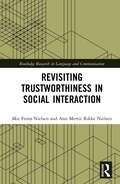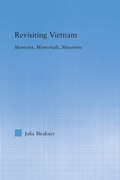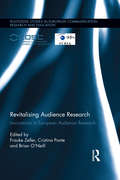- Table View
- List View
Revisionist Histories
by Marnie Hughes-WarringtonRevision and revisionism are generally seen as standard parts of historical practice, yet they are underexplored within the growing literature on historiography. In this accessibly written volume, Marnie Hughes-Warrington discusses this paucity of work on revision in history theory and raises ethical questions about linear models and spatial metaphors that have been used to explain it. Revisionist Histories emphasises the role of the authors and audiences of histories alike as the writers and rewriters of history. Through study of digital environments, graphic novels and reader annotated texts, this book shows that the ‘sides’ of history cannot be disentangled from one another, and that they are subject to flux and even destruction over time. Incorporating diverse and controversial case studies, including the French Revolution, Holocaust Denial and European settlers’ contact with Native Americans and Indigenous Australians, Revisionist Histories offers both a detailed account of the development of revisionism and a new, more spatial vision of historiography. An essential text for students of historiography.
Revisiting Ethnolinguistic Vitality: Language and Subcultural Repertoires
by Natasha E. RavyseThis book examines traditional theories of linguistic vitality in the context of subcultural languages. It argues that traditional methods of investigating linguistic vitality are, according to existing literature, not as reliable as they appear and therefore limited in their testability. The author looks at themes such as the relationships between language and culture, ethnicity within the scope of sociolinguistics, and the notion of ideolinguistic vitality where traditional views intersect with more contextually current ones. She also highlights the importance of studying the nature and principles of subcultural languages which help better inform our understanding of the superdiverse linguistic world. The volume makes a major contribution to modern sociolinguistics by offering a detailed account of developing a unique measuring instrument to gauge the vitality of subcultural languages, which is applicable to more than just subcultural linguistics. An indispensable text in the study of ethnolinguistic vitality, the book will be of interest to students and researchers of sociolinguistics, applied linguistics, identity theory, philology, language and literature, cultural studies, and postcolonial studies.
Revisiting Gender in European History, 1400–1800 (Routledge Research in Gender and History #31)
by Virginia Langum Elise M. Dermineur Åsa Karlsson SjögrenDo women have a history? Did women have a renaissance? These were provocative questions when they were raised in the heyday of women’s studies in the 1970s. But how relevant does gender remain to premodern history in the twenty-first century? This book considers this question in eight new case studies that span the European continent from 1400 to 1800. An introductory essay examines the category of gender in historiography and specifically within premodern historiography, as well as the issue of source material for historians of the period. The eight individual essays seek to examine gender in relation to emerging fields and theoretical considerations, as well as how premodern history contributes to traditional concepts and theories within women’s and gender studies, such as patriarchy.
Revisiting Italy: British Women Travel Writers and the Risorgimento (1844–61) (Routledge Research in Travel Writing)
by Rebecca ButlerWith the rise of mass tourism, Italy became increasingly accessible to Victorian women travellers not only as a locus of artistic culture but also as a site of political enquiry. Despite being outwardly denied a political voice in Britain, many female tourists were conspicuous in their commitment to the Italian campaign for national independence, or Risorgimento (1815–61). Revisiting Italy brings several previously unexamined travel accounts by women to light during a decisive period in this political campaign. Revealing the wider currency of the Risorgimento in British literature, Butler situates once-popular but now-marginalized writers: Clotilda Stisted, Janet Robertson, Mary Pasqualino, Selina Bunbury, Margaret Dunbar and Frances Minto Elliot alongside more prominent figures: the Shelley-Byron circle, the Brownings, Florence Nightingale and the Kemble sisters. Going beyond the travel book, she analyses a variety of forms of travel writing including unpublished letters, privately printed accounts and periodical serials. Revisiting Italy focuses on the convergence of political advocacy, gender ideologies, national identity and literary authority in women’s travel writing. Whether promoting nationalism through a maternal lens, politicizing the pilgrimage motif or reviving gothic representations of a revolutionary Italy, it identifies shared touristic discourses as temporally contingent, shaped by commercial pressures and the volatile political climate at home and abroad.
Revisiting Narnia: Fantasy, Myth And Religion in C. S. Lewis' Chronicles
by Shanna CaugheyTheologians, psychologists, academics, feminists, and fantasists offer humor, insight, and fresh perspectives on the enchanting and beloved Chronicles of Narnia series. Such contributors as fantasists Sarah Zettel and Lawrence Watt-Evans, children's literature scholar Naomi Wood, and C.S. Lewis scholars Colin Duriez and Joseph Pearce discuss topics such as J.R.R. Tolkien and Middle Earth's influence on the conception of Narnia, the relevance of allegory for both Christians and non-Christians, the idea of divine providence in Narnia, and Narnia's influence on modern-day witchcraft. Fans of the wildly popular series will revel in the examination of all aspects of C.S. Lewis and his magical Narnia.
Revisiting Peace Journalism in the Kenyan News Landscape (Routledge Focus on Journalism Studies)
by Cecilia Arregui OliveraThis book revisits the concept of peace journalism, a framework that emerged to question and redefine the professional ethos of conflict reporting by challenging traditional news values, such as the focus on negativity, violence, and the elites, to emphasise reconciliation and dialogue, contextualisation of conflicts and giving voice to all involved parties.The author argues that in a globalised and diverse world, the notion of peace journalism continues to mutate and evolve every time it enters specific contexts and, for that matter, it cannot be regarded as a one-size-fits-all approach. The book reviews and challenges the dominant ways in which peace journalism has been studied and understood to date, before exploring the multiple tensions and relationships between notions of peace journalism and journalistic roles and practices in the reporting of electoral conflict and terrorism by legacy newspapers in Kenya. After deconstructing this complex concept and tracing its motions, mutations, and evolutions in a specific setting, peace journalism is redefined as a dynamic concept that is continuously negotiated between the particulars of context and a shared essence that circles around the values of peace, non-violence, and reconciliation.This book will interest journalism and media studies scholars, educators, and graduate students, in particular those interested in or specialising in peace journalism or conflict reporting, or the East African (or Kenyan) news media scene.
Revisiting Richardson (Transits: Literature, Thought & Culture, 1650-1850)
by Bonnie Latimer Declan Kavanagh Heather Ann Ladd Amelia Dale Samuel Rowe Kerry Sinanan Rebecca Anne Barr Sarah Berkowitz E. Derek TaylorThe preoccupations of eighteenth-century novelist Samuel Richardson—the inequities of gender and sexuality; race and white femininity; masculinity, sadism, and control; religion and selfhood; authorship and artistic form—continue to resonate with contemporary readers. This fresh collection reconsiders his oeuvre, expanding and significantly updating critical debate on its meaning and importance. In these lively and engaging essays, contributors examine historically overlooked works, provide new readings of his best-known novels Pamela and Clarissa, and stake a serious claim for the importance of his final novel, Sir Charles Grandison. Diverse, inventive, and provocative, these essays demonstrate the complexity, relevance, and surprising legacies of Richardson’s novels and characters—finding traces in post-conceptual poetry, detective fiction, and in the fantasies of historical romance. Revisiting Richardson reflects on a decade of scholarship while delivering innovative perspectives on an author whose work continues to be indispensable for understanding the history of the novel. Published by Bucknell University Press. Distributed by Rutgers University Press.
Revisiting Shakespeare’s Italian Resources: Memory and Reuse (Anglo-Italian Renaissance Studies)
by Silvia BigliazziRevisiting Shakespeare’s Italian Resources is about the complex dynamics of transmission and transformation of the Italian sources of twelve Shakespearean plays, from The Two Gentlemen of Verona to Cymbeline. It focuses on the works of Sir Giovanni Fiorentino, Da Porto, Bandello, Ariosto, Dolce, Pasqualigo, and Groto, as well as on commedia dell’arte practices. This book discusses hitherto unexamined materials and revises received interpretations, disclosing the relevance of memorial processes within the broad field of intertextuality vis-à-vis conscious reuses and intentional practices.
Revisiting Shakespeare’s Lost Play
by Deborah C. PayneThis collection of essays centres on Double Falsehood, Lewis Theobald's 1727 adaptation of the "lost" play of Cardenio, possibly co-authored by John Fletcher and William Shakespeare. In a departure from most scholarship to date, the contributors fold Double Falsehood back into the milieu for which it was created rather than searching for traces of Shakespeare in the text. Robert D. Hume's knowledge of theatre history permits a fresh take on the forgery question as well as the Shakespeare authorship controversy. Diana Solomon's understanding of eighteenth-century rape culture and Jean I. Marsden's command of contemporary adaptation practices both emphasise the play's immediate social and theatrical contexts. And, finally, Deborah C. Payne's familiarity with the eighteenth-century stage allows for a reconsideration of Double Falsehood as integral to a debate between Theobald, Alexander Pope, and John Gay over the future of the English drama.
Revisiting The Tempest
by Silvia Bigliazzi Lisanna CalviRevisiting The Tempest offers a lively reconsideration of how The Tempest encourages interpretation and creative appropriation. It includes a wide range of essays on theoretical and practical criticism focusing on the play's original dramatic context, on its signifying processes and its present-time screen remediation.
Revisiting the Assessment of Second Language Abilities: From Theory to Practice
by Sahbi HidriThis book presents an overview of revisiting the assessment of language abilities. It also showcases how the measurement of such constructs can result in negative or positive washback and how outcomes might be conducive to repercussions that decide on the future of many stakeholders. The 23 chapters were selected among tens of chapters received from different contexts that addressed the issue of revisiting the assessment of language abilities, such as Tunisia, Ukraine, Algeria, Russia, KSA, Sudan, Egypt, Canada, Kurdistan, UK, USA, Iran, Turkey, etc. These contexts have highlighted the necessity to revisit the different constructs which should be assessed with a clear and straightforward foundation on students' learning objectives and their actual language ability. To do so, most of the chapters present hands-on use of relevant statistical tests that might serve in revisiting the construct definition both theoretically and operationally. Perhaps the sole and intricate question that the authors of these contributions ask is what it means to revisit the assessment of the construct of individualized language ability and how. In addition, the book accentuates the momentousness and significance of reflecting on test fairness and validation as the mainspring and backbone for democratization of assessment. This book appeals to a broad readership, such as English Language Teaching (ELT) practitioners, language teachers, students, testing organizations, policy-makers, test designers, writers of test specifications, testing experts, researchers, program evaluators, especially in the Middle East and North Africa (MENA) as well as other international contexts.
Revisiting the Elegy in the Black Lives Matter Era (Routledge Research in American Literature and Culture)
by Tiffany Austin; Sequoia Maner; Emily Ruth Rutter; darlene anita scottRevisiting the Elegy in the Black Lives Matter Era is an edited collection of critical essays and poetry that investigates contemporary elegy within the black diaspora. Scores of contemporary writers have turned to elegiac poetry and prose in order to militate against the white supremacist logic that has led to recent deaths of unarmed black men, women, and children. This volume combines scholarly and creative understandings of the elegy in order to discern how mourning feeds our political awareness in this dystopian time as writers attempt to see, hear, and say something in relation to the bodies of the dead as well as to living readers. Moreover, this book provides a model for how to productively interweave theoretical and deeply personal accounts to encourage discussions about art and activism that transgress disciplinary boundaries, as well as lines of race, gender, class, and nation.
Revisiting the Mexican Student Movement of 1968
by Juan J. RojoTracing the evolution of Mexican literary and cultural production following the Tlatelolco massacre, this book shows its progression from a homogeneous construct set on establishing the "true" history of Tlatelolco against the version of the State, to a more nuanced and complex series of historical narratives. The initial representations of the events of 1968 were essentially limited to that of the State and that of the Consejo Nacional de Huelga (National Strike Council) and only later incorporated novels and films. Juan J. Rojo examines the manner in which films, posters, testimonios, and the Memorial del 68 expanded the boundaries of those initial articulations to a more democratic representation of key participants in the student movement of 1968.
Revisiting the Poetic Edda: Essays on Old Norse Heroic Legend (Routledge Medieval Casebooks)
by Carolyne Larrington Paul AckerBringing alive the dramatic poems of Old Norse heroic legend, this new collection offers accessible, ground-breaking and inspiring essays which introduce and analyse the exciting legends of the two doomed Helgis and their valkyrie lovers; the dragon-slayer Sigurðr; Brynhildr the implacable shield-maiden; tragic Guðrún and her children; Attila the Hun (from a Norse perspective!); and greedy King Fróði, whose name lives on in Tolkien’s Frodo. The book provides a comprehensive introduction to the poems for students, taking a number of fresh, theoretically-sophisticated and productive approaches to the poetry and its characters. Contributors bring to bear insights generated by comparative study, speech act and feminist theory, queer theory and psychoanalytic theory (among others) to raise new, probing questions about the heroic poetry and its reception. Each essay is accompanied by up-to-date lists of further reading and a contextualisation of the poems or texts discussed in critical history. Drawing on the latest international studies of the poems in their manuscript context, and written by experts in their individual fields, engaging with the texts in their original language and context, but presented with full translations, this companion volume to The Poetic Edda: Essays on Old Norse Mythology (Routledge, 2002) is accessible to students and illuminating for experts. Essays also examine the afterlife of the heroic poems in Norse legendary saga, late medieval Icelandic poetry, the nineteenth-century operas of Richard Wagner’s Der Ring des Nibelungen, and the recently published (posthumous) poem by Tolkien, The Legend of Sigurd and Gudrún.
Revisiting the Toolbox of Discourse Studies: New Trajectories in Methodology, Open Data, and Visualization (Postdisciplinary Studies in Discourse)
by Markus RheindorfThis book revisits discourse analytic practice, analyzing the idea that the field has access to, provides, or even constitutes a ‘toolbox’ of methods. The precise characteristics of this toolbox have remained largely un-theorized, and the author discusses the different sets of tools and their combinations, particularly those that cut across traditional divides, such as those between disciplines or between quantitative and qualitative methods. The author emphasizes the potential value of integrating methods in terms of triangulation and its specific benefits, arguing that current trends in Open Science require Discourse Studies to re-examine its methodological scope and choices, and move beyond token acknowledgements of ‘eclecticism’. In-depth case studies supplement the methodological discussion and demonstrate the challenges and benefits of triangulation. This book will be a valuable resource for students and scholars in Discourse Studies, particularly those with an interest in combining methods and working across disciplines.
Revisiting the Waste Land
by Lawrence S. RaineyThis groundbreaking book of literary detective work alters our understanding of T. S. Eliot's poetic masterpiece, The Waste Land. Lawrence Rainey not only resolves longstanding mysteries surrounding the composition of the poem but also overturns traditional interpretations of the poem that have prevailed for more than eighty years. He shines new light on Eliot's greatest achievement and on the poem's place in the modern canon. Far from the austere and sober monument to neoclassicism that admirers have praised,The Waste Land turns out to be something quite different: something grim and wild, unruly and intractable, violent and shocking and radically indeterminate, yet also deeply compassionate. Rainey looks at how Eliot went about writing the poem and at the sequence in which he composed the parts. Arriving at new insights into the poet's intentions, Rainey unsettles tradition-bound views of the poem and shows us that The Waste Land is even stranger and more startling than we knew.
Revisiting Trustworthiness in Social Interaction (Routledge Research in Language and Communication)
by Mie Femø Nielsen Ann Merrit NielsenBringing together trust research, rhetoric, ethnomethodology and conversation analysis, this book formulates an analytical program for conceptualizing and defining trustworthiness as an empirical research object in social interaction. Revisiting Trustworthiness in Social Interaction examines trustworthiness as a relational and dynamic concept. It reviews sociological and rhetorical approaches to the study of trustworthiness and respecifies it as an interactional phenomenon displayed, tested and negotiated by participants in social interaction. It identifies four participant orientations of trustworthiness that may be foregrounded in peoples’ dynamic identity projects, and it defines the phenomena 'character-bound displays' and 'sequential negotiation of character', both indicative of participants’ orientation to trustworthiness. In this way, the book turns the theoretical concept of trustworthiness into an empirical object of interaction analysis, pointing to a vast number of interactional indicators, which allow interaction analysts to explore if and how interactants orient to trustworthiness in an encounter. Exemplary cases from both mundane and institutional encounters are analyzed using ethnomethodological multimodal conversation analysis showing how trustworthiness is done, challenges, achived, negotiated and lost in interaction. The intended audiences are scholars of conversation analysis, ethnomethodology, rhetoric and the social sciences, especially communication, organizational and leadership studies, and their students.
Revisiting Vietnam: Memoirs, Memorials, Museums (Literary Criticism and Cultural Theory)
by Julia BleakneyThis book explores the memorializing practices of American veterans of the Vietnam War at several of the most significant contemporary sites of memory in the United States and Vietnam. These sites include veterans' memoirs, museum exhibits, replicas of the National Vietnam Veterans Memorial, and tourism to Vietnam. Because war memorializing has, since the late 1960s, shifted focus from national soul searching to personal identity and recovery, I emphasize how contemporary narratives of the war, shaped more by memory than by history, often are detached from the specific history of the war and its political controversies. Drawing on trauma and cultural memory scholarship, as well as empirical data gathered during field research in the U.S. and Vietnam, the author examines how veterans' memorializing practices have become increasingly individualized, commodified, and conservative since the early 1980s.
Revista Aventuras: Aventuras Student Magazine Grade 4 (¡Arriba la Lectura!)
by Gisela O'BrienNIMAC-sourced textbook
Revista Aventuras: ¡Echa un vistazo! [Grade 1] (¡Arriba la Lectura!)
by Gisela O'BrienNIMAC-sourced textbook
Revitalising Audience Research: Innovations in European Audience Research (Routledge Studies in European Communication Research and Education)
by Frauke Zeller Cristina Ponte Brian O'NeillThe revitalisation of audience studies is not only about new approaches and methods; it entails a crossing of disciplines and a bridging of long-established boundaries in the field. The aim of this volume is to capture the boundary-crossing processes that have begun to emerge across the discipline in the form of innovative, interdisciplinary interventions in the audience research agenda. Contributions to this volume seek to further this process though innovative, audience-oriented perspectives that firmly anchor media engagement within the diversity of contexts and purposes to which people incorporate media in their daily lives, in ways often unanticipated by industries and professionals.
Revitalizing Minority Languages: New Speakers of Breton, Yiddish and Lemko (Palgrave Studies in Minority Languages and Communities)
by Michael HornsbyNew speakers are an increasingly important aspect of the revitalization of minority languages since, in some cases, they can make up the majority of the language community in question. This volume examines this phenomenon from the viewpoint of three minority languages: Breton, Yiddish and Lemko.
Revival: The Psychology Of The Poet Shelley (1925) (Routledge Revivals #No. 33)
by Edward Carpenter George BarnefieldLate studies in the Psychology of Sex have led to some interesting speculations with regard to the poet Shelley; and it is with pleasure that I write a few lines by way of introduction to the following paper by my friend, George Barnefield, which puts very clearly, as I think, some points in Shelley's temperament which have hitherto been neglected or misunderstood, and which call for renowned consideration. Not having myself made a special study of the Modern Psychology, I do not pretend to certify to the absolute truth of the theories put forward by Mr. Barnefield, but I do certainly think, after due consideration, that they are worthy of very careful study.
Revival: An elementary handbook (Routledge Revivals)
by Henry Butler ClarkeDuring the time that I have held the Taylorian Teachership of Spanish at Oxford, I have frequently received letters asking what there is to read in Spanish besides Cervantes and Calderon and what editions should be used. The present volume is intended to answer these questions, and to show the position occupied by the great writers in the general scheme of the literature of their country. The various divisions of the great subject have been exhaustively treated up to their several dates by Nicolas Antonio, Ticknor, Amador de los Rios, Schack and Wolf, to whose books I beg to acknowledge my many obligations, hoping at the same time that the present general sketch may be useful to the general reader, and to the beginner, and may serve as an introduction to more extensive works.I am aware that a few short extracts, however well chosen can give no adequate idea of the manner of a great writer or of the merits of a great book, and that translations, even by the most skilful hands, are wont to reproduce the defects rather than the beauties of their original. The extracts here printed are intended to relieve the monotony of a long list of short notices of authors, and to illustrate the development of the language and progress of literary method; they are, as far as possible, characteristically Spanish in subject and, it is hoped, of sufficient interest to induce readers to refer to the books from which they are taken
